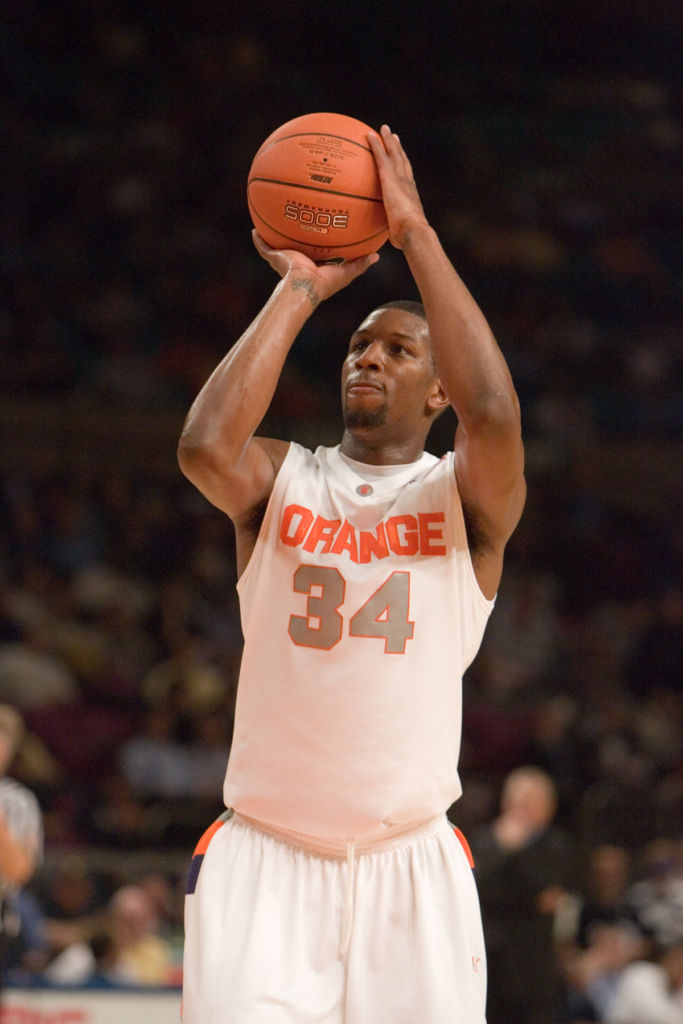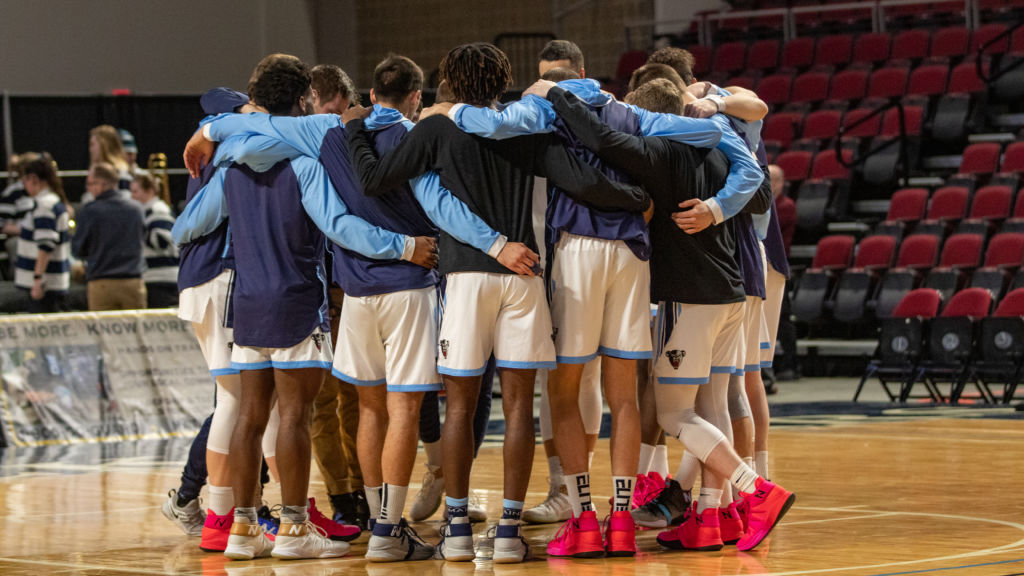The globalization of basketball has permeated the college level as 31 international players who played in the NCAA were drafted since 2016.
From the Croatian great Dino Rađa to Arvydas Sabonis, the original ‘unicorn,’ international contributors fill the Naismith Memorial Basketball Hall of Fame in Springfield, Massachusetts. Many of those players demonstrate a traditional pipeline to the NBA. International players have always been able to come directly to the NBA from an overseas league — Pau Gasol, Dirk Nowitzki, and Giannis Antetokounmpo became stars in the United States with that path.
But within the last 30 years, more international players have come to the U.S. with a different destination — college basketball. Pete Moore, director of athletic communications for men’s basketball at Syracuse University — who rostered five international players during the 2019-2020 season — credits the 1992 USA Olympic Basketball Team, also known as the “Dream Team,” for this trend. “As interest in America’s Olympic team grew, it also cast a spotlight on some of the great players being developed overseas,” he said via email. “More and more players were being scouted by NBA teams and that filtered down to the college level.”
According to a study done by Rukkus Blog on 2016-17 college basketball rosters, 11% of players are born outside the US, and from 2007-17, the amount of foreign-players on college rosters is up 40%.
Others working in college athletics agree with Moore’s Dream Team effect. Cris Belvin, assistant director for athletic communications at Stetson University in DeLand, Florida, has 25 years experience in college basketball and said he does not remember working for a team that didn’t have an international player on the roster. He also traces this growth of the NBA game globally to the Dream Team. “Nowadays, I do not know how you build a program without having international kids,” said Belvin.
“Nowadays, I do not know how you build a program without having international kids,” said Belvin.
Philadelphia 76ers beat writer Keith Pompey said the opportunity for great exposure serves as one of the main reasons international players come. “Everyone is not Luka Dončić, a can’t miss prospect,” said Pompey. “There are some dudes that came over and made a niche for themselves. They go to certain schools, and all of a sudden they develop into first round draft picks.”
Former Arizona Wildcat Deandre Ayton, who went first overall in the 2018 NBA Draft, benefitted from the kind of exposure playing on U.S. courts affords, said Gerald Bourguet, NBA Junior editor and Phoenix Suns reporter for Fansided.com. Ayton was born in the Bahamas but went to high school and college in Arizona. Because of that, the Suns knew him. By comparison, Bourguet said, Luka Dončić, drafted two spots behind Ayton, should have gone first. Any who did their homework and watched his Euroleague games were convinced he was the top prospect, Bourguet said. “It was an interesting case of how a lot of people still don’t understand that Euroleague basketball is at a higher level than college basketball right now,” he said, “but because we watch more college basketball here, it is much easier to digest their clips and to access them.”

Another reason international players want to come to America to play college basketball is for the chance at a quality education, Belvin said. “I can’t imagine that very many kids who are coming from Europe to play college basketball are honestly coming believing they are going to be in the NBA,” he said. “That is a nice thought, but the reality and the math just isn’t there.”
But even if they want to come, recruiting overseas players presents a pricey proposition. Every recruit is allowed five official visits to any school recruiting them on the school’s dime. To lower those challenges, Belvin said a lot of international players come to prep school in America first, which makes it easier for colleges to recruit them.
Based on this, the game is seemingly becoming more global even at the college level, and international players will continue to have to adjust their aggressive style just as Demetris Nichols had to adjust when he went overseas. He played at Syracuse from 2003-2007 and spent time in the NBA and the D League, now the G League, before playing overseas for the better part of 10 years. While there, he spent time on two of the best teams in Europe — Panathinaikos and CSKA Moscow.

For those who do earn the chance to play for a college team in America but whose NBA dreams are halted, taking the launch into European basketball requires a different mindset.
“The level of focus, concentration, and desire to play defense every possession was higher for me,” Nichols said. “I came up with the philosophy that if I can still get my numbers offensively, if I can still score between 13-16 points a game, now I can separate myself from the pack, and that is when I could get a call to go to one of the big teams.”
Levell Sanders just finished his first season as an assistant basketball coach at Binghamton University after spending 13 years in the Czech Republic both as a player and a coach. The biggest difference playing internationally is the language barrier, he said. When he first went over as a player in 1998, his head coach didn’t speak English so his assistant coach had to translate for him, forcing things to get lost in translation. Beyond the language barrier, he said the physicality of the game surprises many.
“The physicality is something that guys have to adjust to when they go overseas. On the defensive end, if a guy runs across the lane, you can hit somebody, where you cannot do so in college basketball. You can hand check in Europe. All of those things you have to adjust to,” Sanders said. “Beyond a more physical game, overseas teams play a team game that involves a lot of passes. He said that they lack the overall talent that exists in America so coaches work to generate offense for their teams.”
That difference in play also informs how European players play on American courts. Tyler Neville, is the assistant director of athletic communications for the Maine Black Bears, whose 15-man roster consisted of 13 from overseas during the 2019-2020 season. “With college basketball, especially with these mid-major schools,” he says, “it is really easy to get in to give the ball to our best player and go to work mode, to run our best player off screens and let him shoot the lights out.” He attributes the offense they run at Maine to two influences — the European influx and coach Richard Barron’s philosophy. “It is run your sets to the last five seconds of the shot clock and when you get there,” he said, “the idea is to have an open shot.”

Maine has had some really great isolation players, Neville said, particularly their two seniors from this past season — at a similar school, he said those players would probably be taking 30 shots a game. Instead, you see a lot of players averaging eight to 12 points because the ball gets spread around, he said, it is very methodical and all-inclusive. “Instead of fitting one players incredible strengths and letting that overtake the game,” he said, “it is figuring out where everyone fits in the system.”
“Instead of fitting one players incredible strengths and letting that overtake the game,” he (Neville) said, “it is figuring out where everyone fits in the system.”
Soon, the differences in play, fans, and coaching strategy might be less dramatic as the global game grows and players move more freely and frequently. Recently, the G League, the NBA’s development league, has lured high-profile recruits away from colleges, potentially upending the traditional college basketball model of playing one year in college before going to the NBA.
Bourguet said that playing overseas, you can get paid a lot more than the G League, and until that changes, he doesn’t think we will see much of a switch on of players choosing to play in the G League as opposed to staying overseas.
The Arizona Republic’s Phoenix Suns insider Duane Rankin said because the international game has become so established and global, there isn’t as much of a barrier for international players coming to America to play. He said that the international system is working for them to remain overseas and that there are too many examples of players overseas being successful when coming to the NBA to play to go to the G League.
Nichols thinks otherwise. “Every night you are showcasing your game and your skills in front of NBA scouts (playing in the G League). When I was doing the Westchester Knicks games (as a broadcaster for MSG Networks), there were at least three to four scouts there every night,” he said.
Similar to college basketball, exposure from the G League also makes it a viable option for international prospects to make it into the NBA. With the NBA now allowing select top prospects to make $125,000 a year before trying to get into the NBA, a combination of the money and exposure may make the G-League an enticing option for some internationals.
“You cannot get that (exposure) at every college game,” Nichols said. “You cannot get that at every European game. The G-League is probably the next best thing or the next step you have to make to get to the pros.”
Header image created by Nicholas D’Alessandro using Adobe Photoshop

